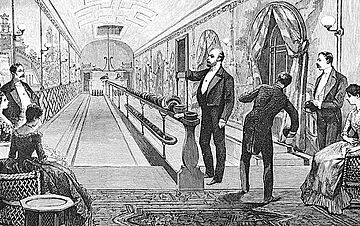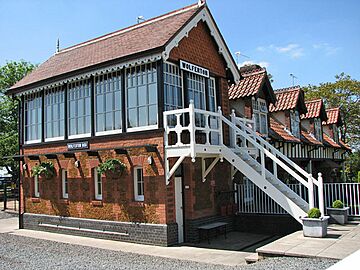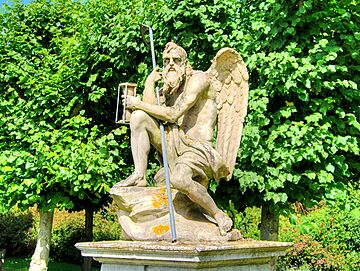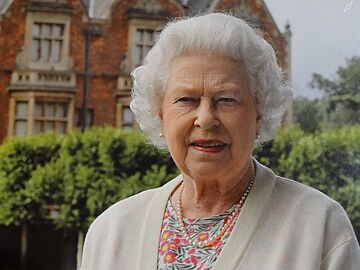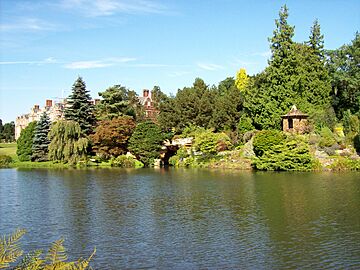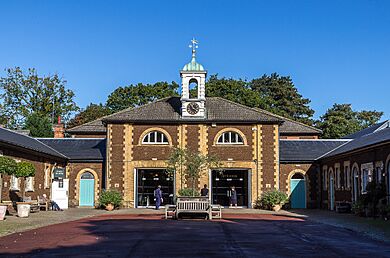Sandringham House facts for kids
Quick facts for kids Sandringham House |
|
|---|---|

"The most comfortable house in England"
|
|
| Type | Country house |
| Location | Near Sandringham, Norfolk, England |
| Built | 1870–1892 |
| Built for | Albert Edward, Prince of Wales |
| Architect | A. J. Humbert Robert William Edis |
| Architectural style(s) | Jacobethan |
| Owner | Charles III (personally) |
| Official name: Sandringham House | |
| Type | Grade II* |
| Designated | 18 September 1987 |
| Reference no. | 1001017 |
| Lua error in Module:Location_map at line 420: attempt to index field 'wikibase' (a nil value). | |
Sandringham House is a large country house located in Sandringham, Norfolk, England. It is one of the homes owned by the British royal family. Both George VI, who was the grandfather of the late Elizabeth II, and George V, her great-grandfather, passed away at Sandringham.
The house sits on a huge 20,000-acre estate in a beautiful natural area called the Norfolk Coast Area of Outstanding Natural Beauty. Sandringham House is considered a very important historical building, listed as Grade II*. Its amazing gardens, park, and woodlands are also listed on the National Register of Historic Parks and Gardens.
People have lived on this site since the time of Queen Elizabeth I, when a large manor house was first built. This house was replaced in 1771 by a new mansion in the Georgian style. In 1836, a London merchant named John Motteux bought Sandringham. When he died in 1843, he left the estate to Charles Spencer Cowper. Cowper later sold other properties and started rebuilding at Sandringham.
In 1862, Albert Edward, Prince of Wales (who later became King Edward VII), bought Sandringham and nearly 8,000 acres of land for £220,000. He wanted it as a country home for himself and his future wife, Princess Alexandra of Denmark. Between 1870 and 1900, the house was almost completely rebuilt in a style called "Jacobean," which means it looked like buildings from the time of King James I. Edward also improved the estate, making it one of the best places for hunting in England.
After Edward VII passed away in 1910, the estate went to his son, George V. George V loved Sandringham, calling it "the place I love better than anywhere else in the world." It was from here that the first royal Christmas broadcast was made in 1932. George V died at the house on January 20, 1936. The estate then went to his son Edward VIII. When Edward VIII decided to step down as king, Sandringham, which was his private property, was bought by his brother, George VI. George VI also loved the house, writing to his mother, Queen Mary, "I have always been so happy here and I love the place." He died at Sandringham on February 6, 1952.
After King George VI's death, Sandringham passed to his daughter, Elizabeth II. The Queen usually spent about two months each winter at Sandringham, including the anniversary of her father's death and her own Accession Day in early February. In 1957, she made her first televised Christmas message from Sandringham. In the 1960s, there were ideas to knock down the house and build a new, modern one, but these plans were not carried out. In 1977, to celebrate her Silver Jubilee, the Queen opened the house and its grounds to the public for the first time. Unlike royal palaces like Buckingham Palace or Windsor Castle, Sandringham (and Balmoral Castle in Scotland) is owned personally by the monarch, not by the Crown. In 2022, after the Queen's passing, Sandringham went to her son and heir, Charles III.
Contents
Exploring Sandringham's Past
Early Beginnings
Sandringham is mentioned in the Domesday Book of 1086 as "sant-Dersingham," meaning "the sandy part of Dersingham." The land was given to a Norman knight after the Norman Conquest. Evidence of a Roman villa's pavements has been found nearby. In the 15th century, the land was held by Anthony Woodville, Lord Scales. During the time of Queen Elizabeth I, a manor house was built where the current house stands. By the 18th century, this house belonged to the Hoste Henley family. In 1771, Cornish Henley cleared the site to build a new Georgian mansion called Sandringham Hall.
In 1834, Henry Hoste Henley passed away without children. The estate was then bought by John Motteux, a merchant from London. Motteux also had no direct heirs. When he died in 1843, he left Sandringham to Charles Spencer Cowper. Cowper was a diplomat living in Paris at the time. After inheriting the estate, he sold his other properties and made Sandringham his main home. He added to the hall, including a fancy porch and a conservatory. Cowper lived a very expensive life, and within 10 years, the estate had a large mortgage. The death of their only child in 1854 led Cowper and his wife to spend even more time abroad. By the early 1860s, Cowper wanted to sell the estate.
Edward VII's Vision
In 1861, Albert Edward, Queen Victoria's oldest son and heir, was almost 20 years old. His father, Prince Albert, believed that getting married and having a proper country home would help the prince settle down. Prince Albert had his staff look at 18 possible country estates. Sandringham Hall was on this list. The Prime Minister, Lord Palmerston, who was the stepfather of Sandringham's owner, recommended the estate to Prince Albert. The sale was agreed upon in February 1862, and it was finalized that October. Queen Victoria, who paid for the house, only visited it twice. Over the next 40 years, Edward spent a lot of money to create a house and estate that his friend Charles Carington called "the most comfortable in England."
The price paid for Sandringham, £220,000, was considered very high by some. However, the house soon turned out to be too small for the Prince of Wales and his many guests after he married in March 1863. In 1865, the prince hired A. J. Humbert to tear down the original hall and build a much larger house. The new red-brick house was finished by late 1870. The only part of the old house that remained was a fancy conservatory. Edward had this room turned into a billiard room. A plaque in the entrance hall says that "This house was built by Albert Edward Prince of Wales and Alexandra his wife in the year of our Lord 1870." The building had living and sleeping areas on three floors, plus attics and a basement. The Norfolk countryside reminded Alexandra of her home country, Denmark.
Within 10 years, the house was again too small. In 1883, a new part, called the Bachelors' Wing, was built by a Norfolk architect, Colonel R. W. Edis. Edis also built a new billiard room and changed the old conservatory into a bowling alley. In 1891, a serious fire broke out in the house. Edis was called back to rebuild and add more sections. He tried to make these new parts match the original style of the house, using similar bricks and stone.
The house had modern facilities for its time. The kitchens and lighting used gas from the estate's own plant. Water came from the Appleton Water Tower, built at the highest point on the estate. The tower was designed in an Italianate style, and Alexandra laid its foundation stone in 1877.
The royal couple's changes at Sandringham were not just to the house. The wider estate was also transformed. Beautiful gardens and kitchen gardens were created, employing over 100 gardeners at their busiest. Many estate buildings were constructed, including cottages for staff, kennels, a school, and a staff clubhouse. Edward also made Sandringham one of the best places for shooting parties in England. To have more daylight for shooting, which happened from October to February, the prince started the tradition of Sandringham Time. All clocks on the estate were set half an hour ahead of GMT. This tradition continued until 1936. Edward's parties were famous, and huge numbers of game birds, like pheasants and partridges, were hunted. The game books recorded between 6,000 and 8,000 birds in the 1870s, rising to over 20,000 a year by 1900.
Guests for Sandringham house parties usually arrived at Wolferton railway station, about 2.5 miles from the house. They traveled on royal trains from London. The station served the house from 1862 until it closed in 1969. After that, the royal family and their guests usually traveled by car from King's Lynn. Edward also started the Sandringham stud (a place for breeding horses) in 1897. His racehorses, Persimmon and Diamond Jubilee, were very successful. While his son and grandsons were not as interested in horses, his great-granddaughter, Elizabeth II, continued the stud and bred many winning horses.
On January 14, 1892, Edward's oldest son and heir, Prince Albert Victor, Duke of Clarence and Avondale, passed away from pneumonia at the house. He is remembered in the clock tower, which has a Latin message meaning "the hours perish and will be charged to our account."
George V's Reign
In his will, Edward VII left his wife, Queen Alexandra, £200,000 and the right to live at Sandringham for the rest of her life. Because Queen Alexandra continued to live in the main house, George V, his wife Queen Mary, and their growing family had to stay at York Cottage on the grounds. This was a bit "cramped." George V was very traditional and wanted to keep the Sandringham estate life as his father had established it. Life at York Cottage gave him a break from his royal duties.

The First World War caused even greater changes. The Sandringham estate and village suffered a major loss when almost all members of the King's Own Sandringham Company, a local army unit, were killed during the Gallipoli Campaign. A memorial to those who died was built on the estate. Names of those killed in the Second World War were added later.
After Queen Alexandra's death at Sandringham on November 20, 1925, the King and his family moved into the main house. In 1932, George V gave the first of the royal Christmas messages from a studio set up at Sandringham. The speech, written by Rudyard Kipling, began, "I speak now from my home and from my heart to you all." George V passed away in his bedroom at Sandringham on January 20, 1936. His body was moved to St Mary Magdalene's Church nearby. Two days later, his body was taken by train from Wolferton to London for his lying in state.
Edward VIII's Brief Time
On the night his father died, Edward VIII immediately ordered that the clocks at Sandringham be set back to Greenwich Mean Time, ending the "Sandringham time" tradition. Edward had rarely enjoyed visiting Sandringham. He described dinners there as "too dull and boring for words." He also found evenings at the "big house" to be "sordidly dull and boring."
Edward was concerned about the cost of running his father's private homes. He called Sandringham a "voracious white elephant" because it cost so much to maintain. He asked his brother, the Duke of York, to review how the estate was managed. The review suggested big cuts, which caused anger among the staff who were let go. After the night his father died, Edward spent only one more night of his reign at the house. He brought Wallis Simpson for a shooting party in October 1936. He never returned to Sandringham. When he stepped down as king, he had to sell Sandringham and Balmoral Castle to his brother, George VI, for £300,000.
George VI's Devotion
George VI was born at Sandringham on December 14, 1895. He loved country activities and was as devoted to the estate as his father. He wrote to his mother, Queen Mary, "I have always been so happy here." The house was closed during the Second World War, but the family made occasional visits, staying in smaller cottages. After the war, the King improved the gardens. December 1945 saw the first Christmas celebration at the house since 1938.
George VI was a heavy smoker and had lung surgery in September 1951. He was never fully well again and passed away at Sandringham in the early morning of February 6, 1952. He had been out shooting the day before and had planned the next day's shoot. He was found in his bedroom, having died of a heart attack at age 56. His body was placed in the Church of St Mary Magdalene before being taken to London.
Elizabeth II's Legacy
Like her ancestors, Sandringham remained one of the two homes owned by Elizabeth II in her private capacity, not as head of state. The other was Balmoral Castle. After her father's death, Queen Elizabeth II would spend the anniversary of his passing and her own accession privately with her family at Sandringham House. Towards the end of her reign, she used it as her official base from Christmas until February. The Queen continued the tradition of celebrating Christmas at Sandringham, unlike Queen Victoria, who celebrated at Windsor Castle.
In January 1957, the Queen accepted the resignation of Prime Minister Anthony Eden at the house. At the end of that year, the Queen made her first televised Christmas broadcast from Sandringham. In the 1960s, there were plans to demolish the house and replace it with a modern building, but these plans were not carried out. However, the interior of the house was modernized, and some smaller buildings were removed. In 1977, for her Silver Jubilee, the Queen opened the house to the public.
Sandringham continued to be used for sporting activities. The Queen also developed a successful gun dog breeding program at Sandringham. She preferred black labrador retrievers, different from the yellow ones her father liked or the terriers her earlier ancestors bred.
From his retirement in August 2017 until his death in April 2021, Prince Philip, the Duke of Edinburgh, spent much of his time at Wood Farm, a large farmhouse on the Sandringham Estate. In February 2022, the Queen celebrated the 70th anniversary of her accession at Sandringham. The Queen made her last visit to Sandringham in early July 2022, after completing her Platinum Jubilee celebrations.
Charles III's Ownership
When his mother, Queen Elizabeth II, passed away in September 2022, the Sandringham estate went to King Charles III. Following the tradition of Queen Elizabeth II, the King and Queen host members of the royal family at Sandringham over Christmas. This includes attending church services together on Christmas Day.
House Design and Rooms
The house is mostly built of red brick with limestone decorations. A local stone called Norfolk Carrstone is also used, especially in the parts added by Edis. The tiled roof has nine groups of chimneys. The style is called Jacobethan, inspired by nearby Blickling Hall. The main rooms in the house are the saloon, the drawing room, the dining room, and the ballroom. There are also rooms for sports, like the gun room, or for fun, like the bowling alley (now a library) and the billiard room. The hallways connecting the main rooms display a collection of weapons and armor from the Middle East and India, collected by Edward VII on his trip in 1875–1876.
The Saloon
The saloon is the largest room in the house and is used as the main reception area. It has portraits of Queen Victoria and Prince Albert. The saloon was used for dances until the new ballroom was built. It has a special balcony for musicians. The room also has a weighing machine. Edward VII used to ask his guests to be weighed when they arrived and again when they left, to show that his generous hospitality had made them gain weight!
The Drawing Room
The drawing room is described as the most grand room at Sandringham. Queen Victoria once wrote in her journal that after dinner, the party went to "the very long and handsome drawing room with painted ceiling and two fireplaces." The room has portraits of Queen Alexandra and her daughters. White marble statues complete the look of this fashionable Victorian room.
The Ballroom
The ballroom was added by Edis in 1884. Before this, the saloon was the only large room for entertaining, and furniture had to be moved every time there was a dance. Queen Alexandra was very happy with the new ballroom, saying it was "beautiful I think & a great success." Queen Elizabeth II used the room for parties and as a cinema.
The Dining Room
The walls of the dining room are decorated with Spanish tapestries, including some by Goya, which were a gift from Alfonso XII of Spain. The walls are covered in oak panels, painted light green for Queen Mary, who was inspired by a visit to a Scottish castle. The dining room could easily seat 24 people for dinner, which was a common number for a large country house at the time.
Gardens and Grounds
The gardens and country park cover 600 acres of the estate, with the main gardens taking up 49 acres. They were mostly designed starting in the 1860s. Edward VII got advice from experts on how to lay out the gardens. Two new lakes were dug further from the house and surrounded by rockeries. A summerhouse called The Nest stands above the Upper Lake. It was a gift to Queen Alexandra in 1913.
The gardens to the north of the house were redesigned after the Second World War for King George VI and his wife. A statue of Father Time, from the 18th century, was bought by the Queen Mother and placed there in 1951. Other parts of the gardens were redesigned in the 1960s for Queen Elizabeth and Prince Philip. The large kitchen gardens, which used to be very decorative, were turned into lawns during Queen Elizabeth II's reign because they were too expensive to maintain.
The Wider Estate
The 20,000-acre Sandringham estate has some of the best places for shooting in England and is used for royal shooting parties. It covers seven villages. Besides tourism, the estate's main activities are growing crops and forestry. The grounds also had room for Queen Alexandra's many animals, including horses, dogs, and cats. In 1886, a racing pigeon loft was built for birds given to the Duke of York by King Leopold II of Belgium.
The Norwich Gates, designed by Thomas Jeckyll, were a wedding present for Edward and Alexandra from the people of Norfolk.
In 2007, Sandringham House and its grounds were made a protected site. This means it is against the law to enter the house or its grounds without permission. The Sandringham estate has a museum in the old coach house. It shows displays of royal life and the estate's history. The museum also has a large collection of royal cars, including a 1900 Daimler owned by Edward VII and a 1939 fire engine. The coach house and stables were designed by A. J. Humbert when he built the main house. The estate also has several other houses with close ties to the royal family.
Anmer Hall
Anmer Hall is a Georgian house on the grounds. The Prince of Wales bought it in 1896. It was the main country home of Prince William and Princess Catherine until they moved to Adelaide Cottage near Windsor.
Appleton House
When Prince Carl of Denmark (who later became King Haakon VII of Norway) and Princess Maud were married in July 1896, Appleton House was a wedding gift from the bride's parents. Queen Maud loved Appleton, calling it "our little house is a perfect paradise." Their son, Prince Alexander (who would become King Olav V of Norway), was born there in 1903. After Queen Maud died in 1938, King Haakon returned the property. The last people to live there were King George VI and Queen Elizabeth during a visit in World War II, when Sandringham was closed. The house was taken down in 1984.
Park House
Built by Edward VII in 1863, Park House has been owned by the royal family for many years. It was the birthplace of Diana, Princess of Wales, when her father rented the house. It was later run as a hotel by a charity.
Wood Farm
Wood Farm has been part of the Sandringham Estate since Edward VII's time. In the early 20th century, it was home to Prince John, the youngest of King George V and Queen Mary's six children. Prince John had epilepsy and spent much of his short life quietly at Sandringham. He passed away at Wood Farm, his home for his last two years, on January 18, 1919. Prince Philip, Duke of Edinburgh, lived at Wood Farm after he retired from royal duties.
York Cottage
York Cottage, originally called Bachelors' Cottage, was built by Edward, Prince of Wales, soon after he bought Sandringham. It was meant to provide more space for guests. It was home to George V from 1893 until his mother's death allowed him to move into the main house in 1925. Edward VIII once said, "Until you have seen York Cottage you will never understand my father." The cottage was not considered very beautiful. One writer called it "tremendously vulgar and emphatically, almost defiantly hideous." York Cottage is now the estate office for the Sandringham Estate.
Visiting Sandringham
The country park and the visitors' centre are usually open throughout the year. The house, gardens, and museum are typically open annually from late March until late October. After the passing of Elizabeth II, Sandringham was closed for a period of official mourning. The country park later reopened, but the house and garden remained closed to the public until April 2023.
See also
 In Spanish: Sandringham House para niños
In Spanish: Sandringham House para niños




